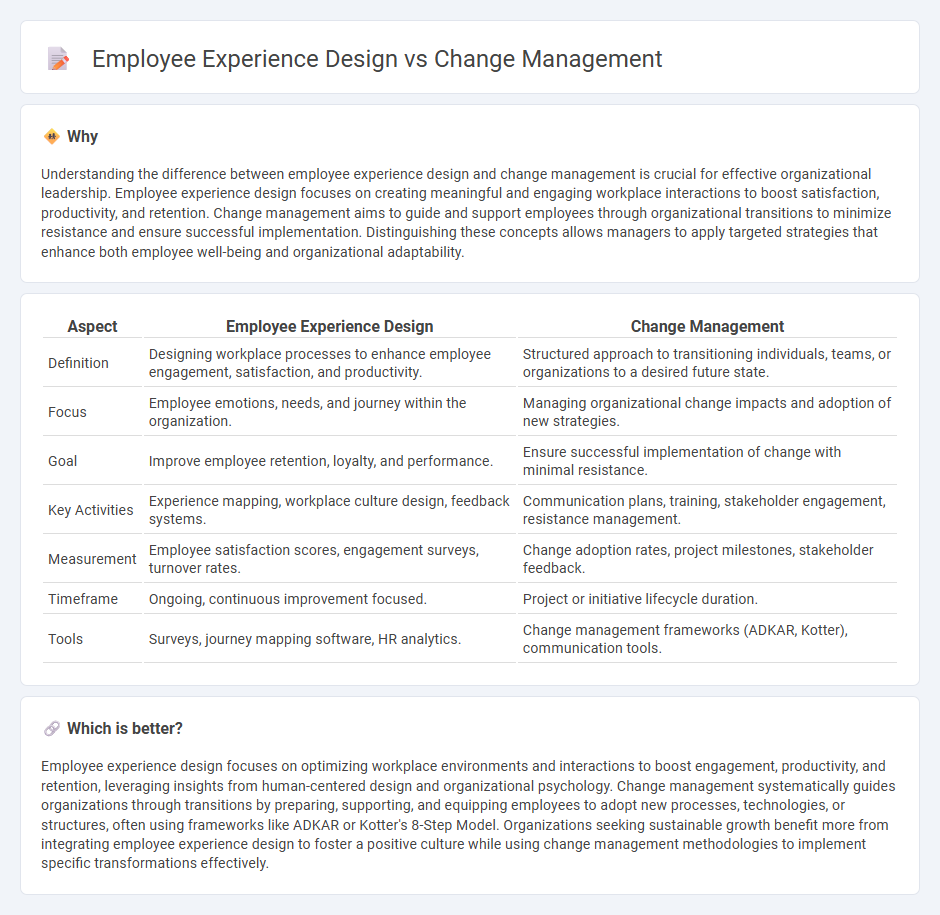
Employee experience design focuses on creating engaging and seamless workplace interactions that enhance productivity and satisfaction, while change management centers on guiding organizations through transitions with minimal disruption. Both strategies leverage data-driven insights and stakeholder collaboration to align business objectives with employee needs. Explore how mastering these disciplines can drive organizational success and workforce engagement.
Why it is important
Understanding the difference between employee experience design and change management is crucial for effective organizational leadership. Employee experience design focuses on creating meaningful and engaging workplace interactions to boost satisfaction, productivity, and retention. Change management aims to guide and support employees through organizational transitions to minimize resistance and ensure successful implementation. Distinguishing these concepts allows managers to apply targeted strategies that enhance both employee well-being and organizational adaptability.
Comparison Table
| Aspect | Employee Experience Design | Change Management |
|---|---|---|
| Definition | Designing workplace processes to enhance employee engagement, satisfaction, and productivity. | Structured approach to transitioning individuals, teams, or organizations to a desired future state. |
| Focus | Employee emotions, needs, and journey within the organization. | Managing organizational change impacts and adoption of new strategies. |
| Goal | Improve employee retention, loyalty, and performance. | Ensure successful implementation of change with minimal resistance. |
| Key Activities | Experience mapping, workplace culture design, feedback systems. | Communication plans, training, stakeholder engagement, resistance management. |
| Measurement | Employee satisfaction scores, engagement surveys, turnover rates. | Change adoption rates, project milestones, stakeholder feedback. |
| Timeframe | Ongoing, continuous improvement focused. | Project or initiative lifecycle duration. |
| Tools | Surveys, journey mapping software, HR analytics. | Change management frameworks (ADKAR, Kotter), communication tools. |
Which is better?
Employee experience design focuses on optimizing workplace environments and interactions to boost engagement, productivity, and retention, leveraging insights from human-centered design and organizational psychology. Change management systematically guides organizations through transitions by preparing, supporting, and equipping employees to adopt new processes, technologies, or structures, often using frameworks like ADKAR or Kotter's 8-Step Model. Organizations seeking sustainable growth benefit more from integrating employee experience design to foster a positive culture while using change management methodologies to implement specific transformations effectively.
Connection
Employee experience design and change management are interconnected through their shared focus on shaping organizational culture and behavior. Effective employee experience design enhances engagement and satisfaction, facilitating smoother adoption of change initiatives by aligning processes with employee needs. Integrating these disciplines ensures sustained performance improvements during transformation efforts by addressing both human and operational factors.
Key Terms
**Change Management:**
Change Management involves structured approaches to transitioning individuals, teams, and organizations from current to desired states, emphasizing communication, training, and stakeholder engagement to minimize resistance and ensure successful adoption. It focuses on managing the human side of change to achieve organizational goals efficiently and sustainably. Explore our detailed insights to understand how effective change management drives transformation success.
Stakeholder Engagement
Stakeholder engagement in change management centers on identifying, analyzing, and actively involving key stakeholders to ensure successful adoption of organizational change initiatives. In employee experience design, stakeholder engagement focuses on understanding employees' needs, emotions, and interactions throughout their journey to create a supportive and motivating work environment. Explore how distinct strategies in stakeholder engagement drive outcomes in both fields for enhanced organizational success.
Communication Strategy
Change management emphasizes structured communication strategies to guide employees through transitions, ensuring clarity, consistency, and alignment with organizational goals. Employee experience design prioritizes personalized communication that fosters engagement, trust, and emotional connection throughout the employee journey. Discover how integrating both approaches can transform workplace culture and drive successful organizational change.
Source and External Links
What is Change Management? Definition & Process - WalkMe - Change management is a systematic approach to handling the human side of organizational change, involving clear vision and objectives, training and resistance management, and continuous evaluation to embed new ways of working into culture.
What is Change Management? - IBM - Change management is a structured method to communicate and implement change by supporting people and processes through transitions such as mergers, technology adoption, and leadership shifts, requiring a comprehensive, adaptable plan for successful adoption.
What is Change Management? Organizational, Process ... - ASQ - Effective change management includes defining and communicating the change, assessing risks, planning with a project-based framework, engaging leadership and employees, and ensuring clear roles and metrics to manage impact and sustain improvements.
 dowidth.com
dowidth.com